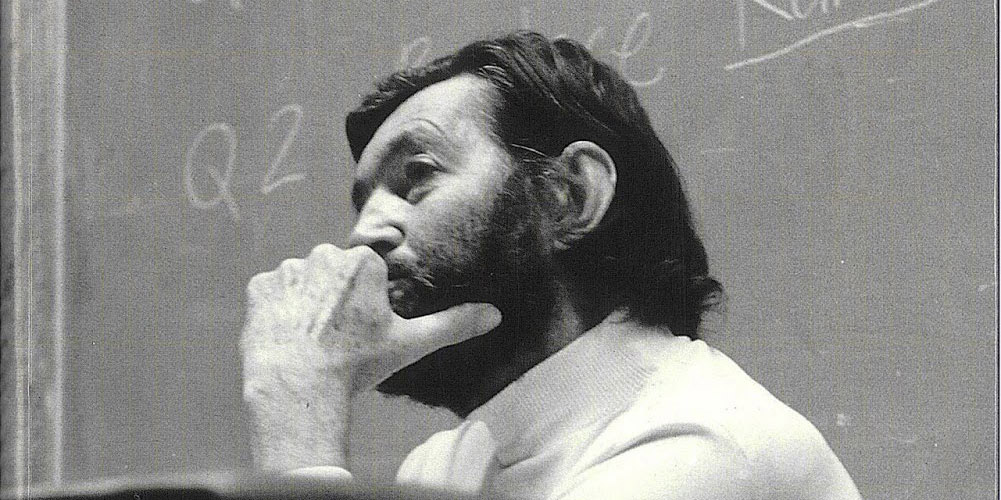



1914–1984
Nadie habrá dejado de observar que con frecuencia el suelo se pliega de manera tal que una parte sube en ángulo recto con el plano del suelo, y luego la parte siguiente se coloca paralela a este plano, para dar paso a una nueva perpendicular, conducta que se repite en espiral o en línea quebrada hasta alturas sumamente variables. Agachándose y poniendo la mano izquierda en una de las partes verticales, y la derecha en la horizontal correspondiente, se está en posesión momentánea de un peldaño o escalón. Cada uno de estos peldaños, formados como se ve por dos elementos, se sitúa un tanto más arriba y adelante que el anterior, principio que da sentido a la escalera, ya que cualquiera otra combinación producirá formas quizá más bellas o pintorescas, pero incapaces de trasladar de una planta baja a un primer piso.
Las escaleras se suben de frente, pues hacia atrás o de costado resultan particularmente incómodas. La actitud natural consiste en mantenerse de pie, los brazos colgando sin esfuerzo, la cabeza erguida aunque no tanto que los ojos dejen de ver los peldaños inmediatamente superiores al que se pisa, y respirando lenta y regularmente. Para subir una escalera se comienza por levantar esa parte del cuerpo situada a la derecha abajo, envuelta casi siempre en cuero o gamuza, y que salvo excepciones cabe exactamente en el escalón. Puesta en el primer peldaño dicha parte, que para abreviar llamaremos pie, se recoge la parte equivalente de la izquierda (también llamada pie, pero que no ha de confundirse con el pie antes citado), y llevándola a la altura del pie, se le hace seguir hasta colocarla en el segundo peldaño, con lo cual en éste descansará el pie, y en el primero descansará el pie. (Los primeros peldaños son siempre los más difíciles, hasta adquirir la coordinación necesaria. La coincidencia de nombre entre el pie y el pie hace difícil la explicación. Cuídese especialmente de no levantar al mismo tiempo el pie y el pie).
Llegado en esta forma al segundo peldaño, basta repetir alternadamente los movimientos hasta encontrarse con el final de la escalera. Se sale de ella fácilmente, con un ligero golpe de talón que la fija en su sitio, del que no se moverá hasta el momento del descenso.
FIN
No one will have failed to observe that frequently the floor bends in such a way that one part rises at a right angle to the plane formed by the floor and then following section arranges itself parallel to the flatness, so as to provide a step to a new perpendicular, a process which is repeated in a spiral or in a broken line to highly variable elevations. Ducking down and placing the left hand on one of the vertical parts and right hand upon the the corresponding horizontal, one is in momentary possession of a step or stair. Each one of these steps, formed as we have seen by two elements, is situated somewhat higher and further than the one prior, a principle which gives the idea of a staircase, while whatever other combination, producing perhaps more beautiful or picturesque shapes, would surely be incapable of translating one from the ground floor to the first floor.
You tackle a stairway face on, for if you try it backwards or sideways, it ends up being particularly uncomfortable. The natural stance consists of holding oneself upright, arms hanging easily at the sides, head erect but not so much so that the eyes no longer see the steps immediately above, while one tramps up, breathing lightly and with regularity. To climb a staircase one begins by lifting that part of the body located below and to the right, usually encased in leather or deerskin, and which, with a few exceptions, fits exactly on the stair. Said part set down on the first step (to abbreviate we shall call it “the foot”), one draws up the equivalent part on the left side (also called “foot” but not to be confused with “the foot” cited above), and lifting this other part to the level of “the foot,” makes it continue along until it is set in place on the second step, at which point the foot will rest, and “the foot” will rest on the first. (The first steps are always the most difficult, until you acquire the necessary coordination. The coincidence of names between the foot and “the foot” makes the explanation more difficult. Be especially careful not to raise, at the same time, the foot and “the foot.”)
Having arrived by this method at the second step, it’s easy enough to repeat the movements alternately, until one reaches the top of the staircase. One gets off it easily, with a light tap of the heel to fix it in place, to make sure it will not move until one is ready to come down.
E-10 km 12
Sant Joan de Labritja
Ibiza 07810
Contacto
info@diegomontero.com
+598 95002 765
Costanera a la Barra s/n
El Tesoro
Maldonado 20001
